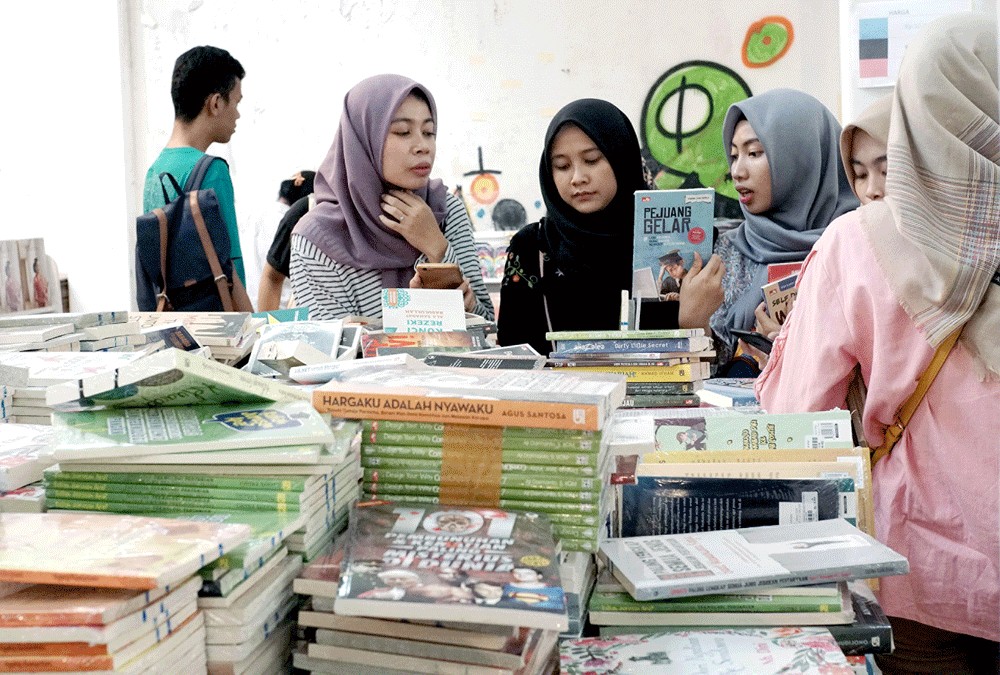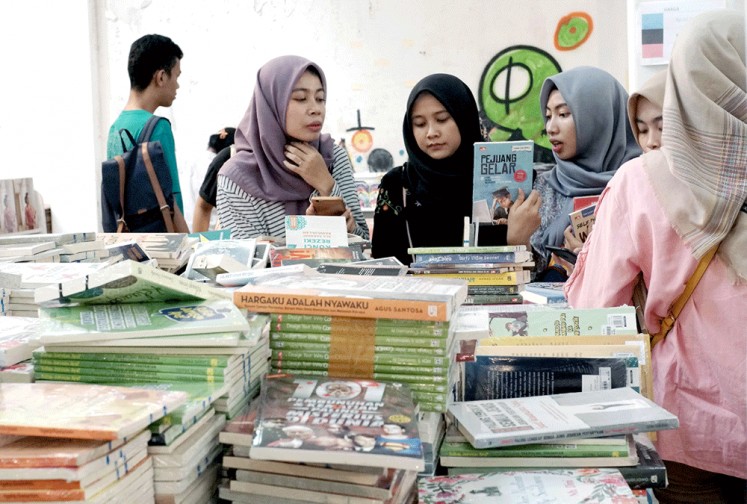Popular Reads
Top Results
Can't find what you're looking for?
View all search resultsPopular Reads
Top Results
Can't find what you're looking for?
View all search resultsGramedia's first Readers Fest attracts public to books
Publisher Gramedia’s first Readers Fest promotes reading in one of the least literate countries in the world.
Change text size
Gift Premium Articles
to Anyone
H
eld at the historic Kota Tua in West Jakarta, Gramedia’s week-long Readers Fest was a showcase of all things books — workshops by writers, a huge book market with discounts of up to 92 percent, as well as several musical guests.
Guest stars included director Wregas Bhanuteja, journalist Najwa Shihab and writers Sapardi Djoko Damono, Gunawan Maryanto and Bernard Batubara as well as cartoonist Muhammad “Mice” Misrad.
Several guests, including Mice, held their own writing and drawing workshops as a way to share their knowledge. Another activity was the zine making workshop organized by Ruang.
Gramedia Digital Nusantara managing director Kelvin Wijaya was personally flattered by the enthusiasm that the public showed regarding this festival.
Five days into the event, held from Oct. 1 to 7, the number of visitors had reached around 7,000.
.img_assist_custom-780x530.gif) Creative minds: The Comics Coloring Wall was popular during the Gramedia’s Readers Fest.
Creative minds: The Comics Coloring Wall was popular during the Gramedia’s Readers Fest.
“We appreciate the public’s interest in this event,” Kelvin says. “[The high interest] makes it clear that there are still many who appreciate the art of reading as well as those who are curious.”
But the enthusiasm shown for this event offers only a small glimmer of hope for a country that is known for having a low interest in reading.
Indonesia is currently at 60th place — only after Botswana — on UNESCO’s 2017 survey on reading interest in the world, the second lowest rate in the database.
One place above Indonesia is Thailand, and the country in first place in that survey is Finland, whose populace reads an average of 30 books a year.
Many argue that it is because the culture of reading has not been implemented into Indonesian habits from the beginning, especially in the era of increased internet connectivity.
Najwa observes that while Indonesia has a literacy rate of around 95.3 percent, the culture of reading books is almost nonexistent as a result of a general disinterest in reading as a leisure activity.
Bookworms: Visitors browse through books on offer at the Book Market held during Gramedia’s Readers Fest at Kota Tua in West Jakarta. (The Jakarta Post/Umair Rizaludin)Speaking likely from her own experience, Najwa said a good way to alleviate this was to try and set aside actual time for reading and get used to doing it so that the habit can be formed. It also helps if the habit is planted at a very young age.
Some of this disinterest, she feels, comes from not wanting to feel bad about not being able to finish any books, as this would trigger embarrassment within oneself.
“Most of the time, when parents have successfully taught their children how to read, they stop there. What is needed is to foster the culture of reading into them so that they can pursue that as a genuine interest and therefore, heighten the culture of reading,” the journalist says.
Another reason why Indonesian literacy is not that established is difficult access.
Najwa recalled individuals she met on her journeys around Indonesia and found moving stories of ordinary individuals that aimed to bring books to hard-to-access areas of Indonesia, and asked “why can’t we do the same?”
Book talk: Literary expert Maman Suherman (center) and journalist Najwa Shihab (right) were keynote speakers at a discussion held during Gramedia’s Readers Fest in Jakarta. (The Jakarta Post/Umair Rizaludin)Former Kompas Gramedia editor in chief Maman Suherman shared the same thought.
“Only around 2 percent of Indonesians now are unable to read. While this is a refreshing fact, interest in reading is still low. Indonesians tend to average about 2 or 3 books a year,” he said.
He also saw the Reader’s Festival as a unique way for Gramedia to foster interest in reading among the public.
“It helps also that this festival is offering a trove of great books at an accessible price and therefore it is easier for them to get hold of books. Every little bit of effort helps.”
Acknowledging the accessibility factor, the festival also coincided with the launch of the publisher’s new mobile app, which aims to answer that very same problem, thereby putting books straight into the phones of many.













